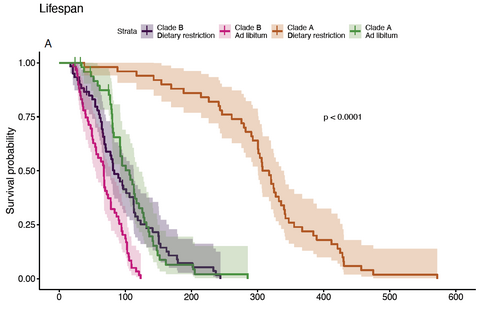
Diversity, plasticity and asynchrony of actuarial and reproductive senescence in the Collembola Folsomia candida
A large proportion of living organisms suffer from senescence: their vital functions tend to decline with age in adult individuals. Are there genetic factors or environmental parameters that enable certain individuals to delay, escape or suffer less from senescence? The study recently published in Frontiers in Ecology and Evolution describes in detail how survival and reproduction decline with age in a species of Collembola.
Flourishing recent comparative studies on senescence have revealed an uncovered diversity across the tree of life of the shapes of the age trajectories of mortality (actuarial senescence) and to a lesser extent of reproduction (reproductive senescence). Evolutionary theories have been called up to explain why some species suffer from positive senescence while others benefit from negligible or even negative senescence. We still know little about how, within a species, the shapes of the age trajectories of different traits are linked to each other and how they vary or covary depending on the genetic background and environmental conditions.

We report here the results of an experimental study whose aim was to describe the actuarial and reproductive senescence in various genetically distinct lineages of a Collembola, a hexapod with indeterminate growth. We compared the age trajectories of individuals raised under two food regimes to study if and how the shapes of these age trajectories are plastically modified by environmental conditions.
We found clear evidence of actuarial and reproductive senescence, especially when the springtails were fully fed. Clutch size increased as female become older and then declined progressively after reproduction reached a maximum. This age decline in fertility went along with a progressive slowing down of the pace of the egg- laying, a reduction of egg quality (more sterile eggs), while egg size undergoes little change with age. We found that the onset of reproductive decline occurred before the beginning of actuarial senescence, and show that escaping senescence is physiologically possible for certain lineages under dietary restricted conditions.
References
Tully T (2023) Diversity, plasticity and asynchrony of actuarial and reproductive senescence in the Collembola Folsomia candida (Willem, 1902). Front. Ecol. Evol. 11:1112045. doi: 10.3389/fevo.2023.1112045
Contact
Thomas TULLY
iEES Paris
iEES
Sous tutelle de Sorbonne université, CNRS, INRA, IRD, P7, UPEC
